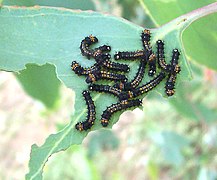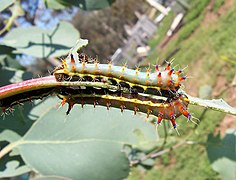Opodiphthera eucalypti
| Opodiphthera eucalypti | ||||||||||||
|---|---|---|---|---|---|---|---|---|---|---|---|---|

Opodiphthera eucalypti |
||||||||||||
| Systematics | ||||||||||||
|
||||||||||||
| Scientific name | ||||||||||||
| Opodiphthera eucalypti | ||||||||||||
| ( Scott , 1864) |
Opodiphthera eucalypti is occurring in Australia butterfly from the family of saturniidae (Saturniidae). The specific epithet is derived from eucalyptus ( Eucalyptus ), the main food plant of the caterpillars.
description
butterfly
The moths reach a wingspan of 120 to 150 millimeters. The females are slightly larger than the males. The coloring and drawing are similar in both sexes. The wings and body vary in color from ocher to pale reddish brown to deep pinkish brown. On the upper side of each wing, an eye spot stands out in the middle , which is somewhat larger and clearer on the often darker hind wings, with a black border and an orange core. Both pairs of wings show a thin, red-brown, whitish, outer transverse line behind the eye-spots. The apex is slightly flared and has a red-brown color. The antennae of the males have a very long and distinct comb teeth, which are less developed in the females. A proboscis is missing.
egg
The egg has an oval shape and a creamy white color. It has a diameter of about two millimeters. The female lays the eggs one by one or in a row on top of a leaf of the food plant.
Caterpillar
Newly hatched caterpillars are black and covered with some short hair. Individuals of the second caterpillar stage continue to show short hairs and black and yellow tubercles . In the third and fourth caterpillar stages, the animals change to a greenish to brownish basic color. The tubercles take on red, yellow and blue colors, from which short hairs grow. The side stripe is yellow. With the fifth and final instar, the caterpillars appear in a strong blue-green color, show many blue and red tubercles and a yellow-white lateral stripe. Your body length is then 70 to 80 millimeters.
Doll
Adult caterpillars spin a very firm cocoon , which is also protected against rain, from brownish silk threads, preferably in a fork of a branch. A few small holes for ventilation are worked into the sides. The pupa lying inside the cocoon is short and stocky and has a red-brown color.
distribution and habitat
Opodiphthera eucalypti is found only in Australia and New Zealand. The species colonizes eucalyptus forests there.
Way of life
The nocturnal moths of Opodiphthera eucalypti fly in one generation in the Australian summer. They do not eat any food. At night they visit artificial light sources . The caterpillars prefer to feed on the leaves of various types of eucalyptus ( Eucalyptus ). However, they were also found on pepper trees ( Schinus ), birches ( Betula ), sweetgum trees ( Liquidambar ) and Prunus species. The caterpillars live from November to March, pupate and the moths hatch the following summer. Depending on the climatic conditions, the pupae can survive for up to five years. That is why the cocoon is very hard and tightly spun. When the butterfly wants to leave the hard shell, it first secretes a liquid that softens the silk cocoon and then cuts a circular hole with sharp hooks that are on the forewings and that fall off after hatching. The caterpillars have a variety of enemies. So they are sometimes eaten by birds, for example by curawongs or prickly pods (Campephagidae). Parasitic wasps (Ichneumonidae) polyhedrosis viruses and fungal parasites are another danger.
Individual evidence
- ^ A b c d e f Charlma Phillips: Emperor Gum Moth , Forest Health Fact Sheets No. 9 of the Department of Primary Industries and Regions, South Australia (PIRSA), 1993, pp. 1-4 PFD
- ↑ Markku Savela: Tanaecia Butler, [1869] - distribution. In: Lepidoptera and some other life forms. Retrieved January 29, 2019 .
Web links
- web.archive.org - Emperor Gum Moth Fact File
- australia stamp - Opodiphthera eucalypti caterpillar on a postage stamp from Australia






